Cruiser Motorcycles For Beginners | A Complete Guide
Updated on | By Mohit Chauhan
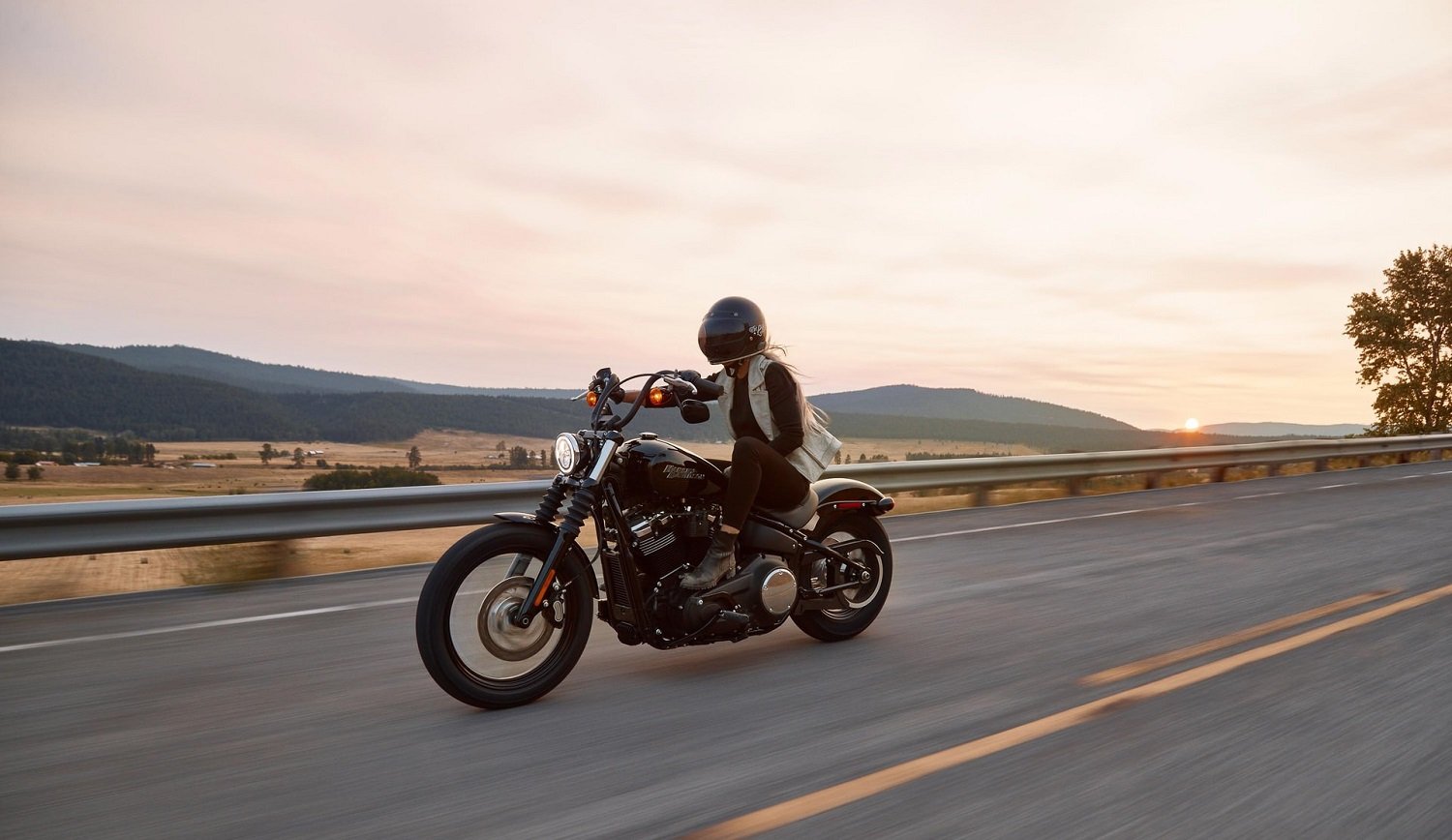
So you have finally decided to consider a cruiser as your first motorcycle. Congratulations, now is the time to fill yourself with all the details before you take your first step. On one hand motorcycles of this class are rather clumsy and heavy. But on the other hand, their low seating position and slow accelerations makes life easier for beginners. The rider’s club in this class do not usually race with each other, not even with cars, thus these rides often reduce the likelihood of an accident.
Furthermore, we will further reduce this risk by helping you choose the right option, where you can safely enter the road for the first time. But let us warn you right away; if you still ignore our advice even after reading this, then at least do not buy an exclusive custom (unique bikes created from scratch by private workshops). In short, a big bulky motorcycle can easily end you up in a wheelchair.
Things To Know Before Buying
A cruiser is not designed for an agile city ride, high-speed chase, or any type of off-road conquest. But they are the ones that attract most public attention, and thus remains a symbol of freedom and the biker lifestyle. A cruiser makes you feel confident by overcoming all the challenges you may face as a beginner, whilst providing maximum riding comfort. This type of bike combines a brutal appearance and a rather sedate ride compared to its sporty and off-road counterparts.
Cruiser, in its classical sense has:
- Straight relaxed seating position: forward pegs, wide comfortable handle bar tilted towards the rider, thick wide seat with a comfortable back support.
- Duplex frame, capacious soft rear suspension, powerful brakes, high-quality wind and mud protection, rake (fork angle) from 30° to 35°, relatively high ground clearance.
- Large engine displacement mostly twin cylinders with a longitudinal V-shaped arrangement. Hence, a long life with a big service interval, decent power reserve for overtaking and maneuvering at good speed.
What should you look in your first motorcycle?
- Forgiving: Look for a motorcycle that will forgive your silly mistakes, like an abrupt throttle or an incorrect way of handling the clutch or brake. A Yamaha R6, for example, in the hands of an inexperienced beginner will not forgive even an extra inch of throttle, and can throw you away from the saddle instantly.
- Inexpensive Parts: While choosing a motorcycle, many pay attention to aesthetics, but do take into consideration the cost of replacing them in case of an accident.
- Mechanically Reliable: Make sure you have tested the engine thoroughly by checking vital engine parts and accessories. There should not be any sort of leakage or grime (commonly found on the base of the engine). If possible take an experienced rider with you to test the bike rigorously.
How to choose a beginner cruiser motorcycle?
- You need to choose between the cruisers by acknowledging your physical capabilities: height, weight, arm length, and general ability to lift weights. A rider helplessly trampling on a bike nestled on its side is a pitiful sight. And even worse is to suddenly realize that the “cruiser”, three times your weight, refuses to bend on a turn under your efforts, but goes further, to the oncoming lane, as if on rails.
- Riders, particularly of an average or below average height that are not outstanding in physique, should not choose a cruiser heavier than 220 kg as their first motorcycle. Additionally the saddle height should not be over 70 cm.
- Tall riders, on the other hand, weighing over 100 kg, should first consider placing their legs on a cruiser comfortably. For them, a small sized cruiser, like the Chinese 250cc models, is not an option. Another thing to be kept in mind is that the angle of leg should not increase from 120°. The wider your legs are placed from this angle, the faster you will get tired, forcing you to take stoppages very frequently.
- Another important parameter is to acknowledge your basic skills in handling the motorcycle: minor repairs, self-replacement of consumables, tuning, etc. If their availability (and the desire to buy them) is almost zero, it is better to abandon the idea of buying an attractive bike from an import auction. Despite the decent photographs and a good service history, you still have to maintain your motorcycle yourself. And if you consider yourself experienced, or a “hands in oil” type of rider, buy yourself a used motorcycle from a private seller, but not the exotic ones, like the Suzuki Savage LS400, which was discontinued 20 years ago. Choose amongst the most recent models so that you may not find any problems while looking for original spare parts or consumables.
- Additionally, always choose a motorcycle that is quite popular and in trend around your country. Like we said earlier, you are choosing a beginner motorcycle, but when you have comfortably outgrown your motorcycle, you may want to sell or upgrade. And it would be great if this is dealt without incurring significant loss in price. The demand for these bikes is usually born by the same types of beginners who prefer something that is popular, durable, and much less exotic. Therefore, as your first beginner motorcycle, choose something that is easy to sell later.
- Another thing to remember is that you are purchasing your first bike for one season only. Such a motorcycle should simply teach you how to ride, give you the skills to ride around the city, and most importantly, make it absolutely clear as to what you want from a motorcycle. It should cause fewer problems and can be sold pretty easily at the end of season. It is not worth chasing plastic, gloss, or vintage cruisers as your first ride. You will be better off buying a 90’s motorcycle in good condition, but do make sure it is not difficult to repair in case you drop it.
- There is no need to consider a Chinese motorcycle, although the China motorcycle industry is rapidly developing and high-quality motorcycles will be launched in near future, but as of now, do avoid them. As a beginner, it is wise to buy a ten year old Japanese motorcycle than a brand new Chinese one. Moreover, when sold, a year old Chinese bike will have a 60% depreciated value.
Technical Specifications and Features of Cruiser Motorcycles
The appearance of a cruiser is difficult to confuse with other motorcycle types. Low comfortable seat, vertical fit, relaxed design, wide rear wheel, large protruding mirrors, short fork are some of the attributes of a cruiser motorcycle. On many models you may find the footrest moved more forward. The passenger seat is in most cases equipped with a backrest. But despite all the signs of comfort, the cruiser looks quite brutal – due to the large fenders and the abundance of chrome elements.
The exteriors of these bikes are quite impressive, but the technical characteristics are not mediocre either:
- It has an engine with a volume ranging from 250cc to 500cc, or 750cc to 2000 cc with a capacity of up to 160 horsepower. It confidently gains momentum and is driven by an impressive mass of iron, which can weigh up to 500 kilograms! Without unnecessary effort, the biker easily manages to get ahead of the flow of vehicles on the road. The engine is designed to obtain maximum torque even at low power levels.
- Most often, the design involves a liquid-cooled V-shaped engine. However, there are Japanese models equipped with one, two, and three-cylinder engines as well.
- The fuel tank capacity ranges between 14 to 18 liters and is sufficiently enough to forget about refueling between gas stations.
- The reinforced braking system is designed considering the massive weight of the bike.
- The maximum speed can reach up to 190 km/h.
10 Best Cruiser Motorcycles For Beginners
The question of choosing a cruiser for a beginner is often quite acute. Still, there are many options, but how to choose the right one?
The first thing that comes in the mind of any novice motorcyclists is the “cubic capacity”. Traditionally, beginners are advised a motorcycle of no more than 400 cubic centimeters of volume, although this is a controversial issue but you shouldn’t get on a powerful bike like Kawasaki VN 2000 Vulcan or Yamaha Stratoliner right away without experience. And don’t be under the misconception that a 1000cc cruiser will be easier to ride than a similar capacity sports bike. Another important aspect to keep in mind is the connection between engine volume and the dimension of the motorcycle as well as its weight. The more powerful the cruiser, the more likely it is to be larger and heavier.
It is worth adding that while buying an inexpensive motorcycle, you do not need to look at its year of manufacturing or the mileage on its odometer, but, you do need to look at its overall condition. How do you do this? There are various tips and tricks to be kept in mind while ‘buying a used motorcycle’, but it is important to acknowledge that it is not always possible to find out the real mileage. However it doesn’t really matter; often the age of the motorcycle and the count of its previous owners are not particularly related to its real technical condition. At times, you will find a 25 year old cruiser in a much nicer condition in comparison with a 5 year old.
An ideal cruiser for a novice motorcyclist should have good dynamics for riding around the city, require a minimum of maintenance, be comfortable, inexpensive (relatively), at the same time stylish, noticeable, and most importantly, be popular enough so that there is a choice amongst the bids while reselling.
Let us take a look at the 10 best beginner cruiser motorcycles along with their technical specifications.
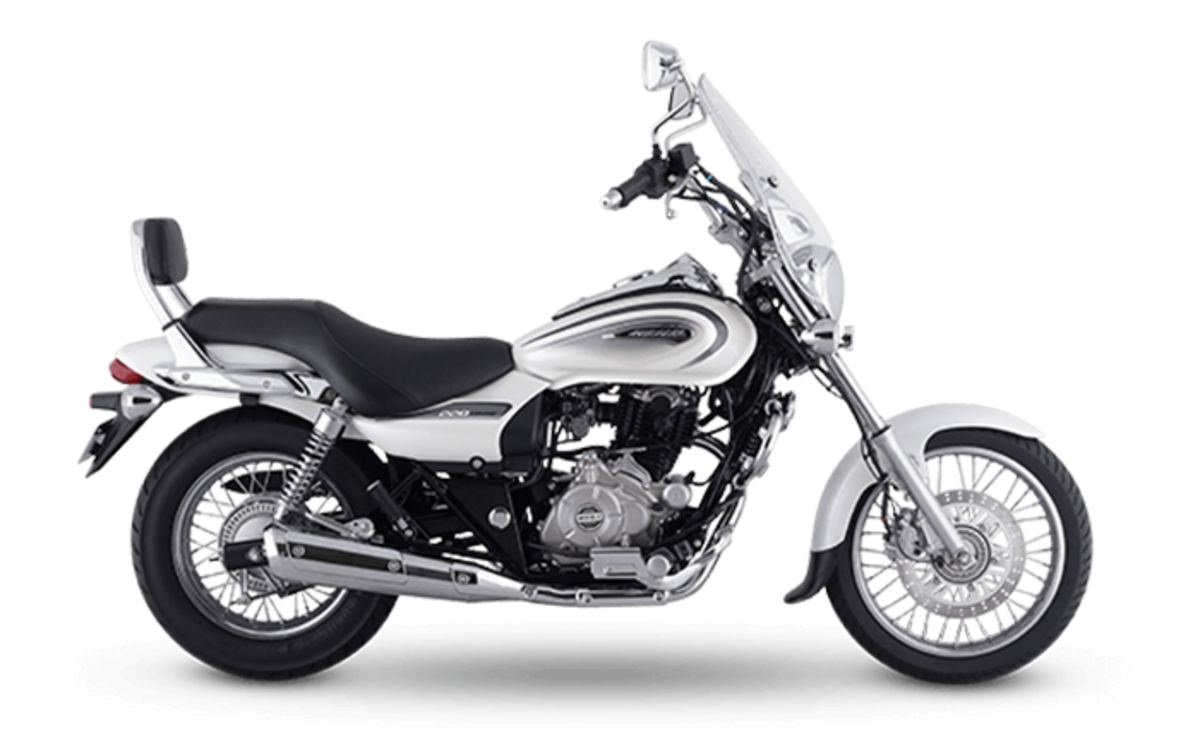
Bajaj Avenger Cruise 220
Avenger is a lightweight, simple, low maintenance bike that is ideal for an inexperienced rider. The engine is a single-cylinder, well-proven economical DTS-I with two-spark ignition and air-oil cooling. It has a comfortable passenger seat for your better half, and comes equipped with an extensive “windscreen” that follows the concept of aerodynamics. With a low center of gravity and a fairly high (170 mm) ground clearance, it is ideal for short heighted riders. Although it is a kind of a hybrid of 250 cc Yamaha and 400 cc Kawasaki Eliminator, but it is a little less pretentious. Designed for around 250 kg load capacity it is perfect for female riders and a medium-built male.
Price | $1,800 |
Engine | 4T, Carburettor, 219cc, 19HP |
Max Speed | 150 Km/h |
Weight | 150 Kg |
Seat Height | 72 cm |
Tank Volume | 14 Liter |
City Consumption | 40 kmpl |
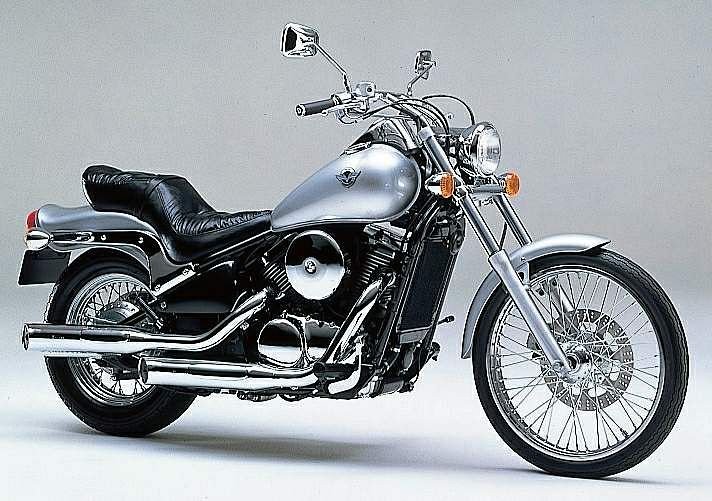
Kawasaki VN 400C Vulcan
The Kawasaki Vulcan 400 cruiser series begins its history in 1985. This motorcycle was built on the basis of an in-line 2-cylinder engine, which was quite resourceful and powerful, and in character, bears little resemblance to classic cruisers. By 1995, the EN400 was leaving the market, giving way to the Kawasaki VN400 Vulcan. The new model already had the usual V-shaped engine and chain drive (the EN400 was equipped with a belt drive). It was this model that gained significant popularity not only in Japan, but also in Europe and America (mainly due to its low cost and similarity to the older 800 cc model). The Kawasaki VN 400C Vulcan model is based on the older version of the Kawasaki VN800 Vulcan, differing only in the engine size, carburettor and other minor changes. The interchangeability of parts of first and the second model is very high – most of the VN400 parts are fully compatible with the VN800.
Price | $2,500 |
Engine | 4T, Carburettor, 399cc, 33HP |
Max Speed | 150 Km/h |
Weight | 234 Kg |
Seat Height | 70 cm |
Tank Volume | 15 Liter |
City Consumption | 35 kmpl |
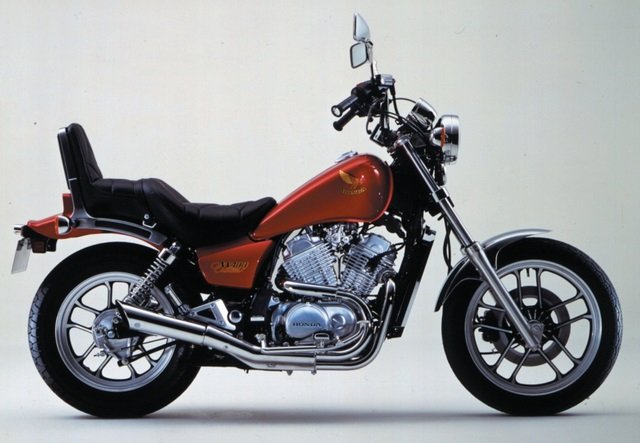
Honda Steed NV 400
The Honda Steed 400 cruiser model first appeared on the Japanese market in 1988 in parallel with the older version of the Honda Steed 600. In the early years of production (until 1991), the model was in extremely low demand and there were even rumors that Honda was planning to reduce the production of this motorcycle. By 1993, however, Japan experienced another boom in American-styled motorcycles, and the Steed 400 quickly became the bestseller. In 10 years of its production, the total number of Steed 400 and 600 sold reached 80,000 units.
Why did both versions exist at the same time? The fact is that in Japan, driving licenses for motor vehicles have a different level, depending on the driving experience. Thus, the Steed 400 could be used by any novice driver who had recently graduated from a motorcycle school (similar to an A2 compliant motorcycle), while the Honda Steed 600 needed a more advanced license. The model was based on a 2-cylinder V-shaped liquid-cooled engine with a volume of 398 cm³; producing 30 Horse powers and 33 NM’s of torque. This motor was also installed on the Honda XL400V Transalp, Honda VRX 400 , Honda Bros 400 and Honda Shadow 400 models .
Price | $2,900 |
Engine | 4T, Carburettor, 398cc, 30HP |
Max Speed | 140 Km/h |
Weight | 203 Kg |
Seat Height | 67 cm |
Tank Volume | 11 Liter |
City Consumption | 22 kmpl |
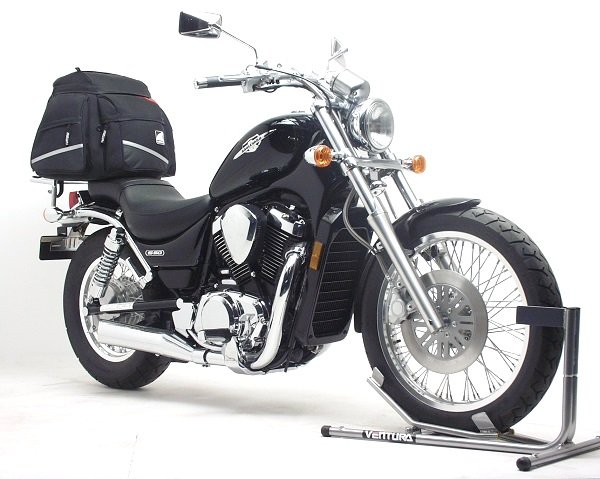
Suzuki VS400 Intruder
The Suzuki VS400 Intruder cruiser was first introduced in 1994 on the basis of the older version of the Suzuki VS800 Intruder. The motorcycle was produced for only about 3 years, after which it came off the assembly line. This was due to the emergence of the Suzuki VZ400 Desperado model, which from the very beginning showed strong demand, while the Suzuki VS400 Intruder did not have high sales. Meanwhile, at present, the Intruder 400 is a fairly popular motorcycle in Asia among novice motorcyclists, mainly due to its low price. For the European market, a 600 cc modification was offered – the Suzuki VS600 Intruder.
The model was based on a V-shaped 2-cylinder liquid-cooled engine with a volume of about 400 cubic meters that outputs around 33 Horse powers and 32 NM’s of torque. This engine was installed practically unchanged on modern Suzuki Boulevard 400 and Suzuki VL400 Intruder Classic models. The Suzuki VS400 Intruder features a classic steel frame, simple suspension in the form of a telescopic fork at the front and a double shock absorber at the rear, a cardan drive, a rear drum brake and a 12-liter fuel tank.
Price | $2,200 |
Engine | 4T, 2-Carburettor, 400cc, 38HP |
Max Speed | 150 Km/h |
Weight | 198 Kg |
Seat Height | 68 cm |
Tank Volume | 13 Liter |
City Consumption | 24 kmpl |
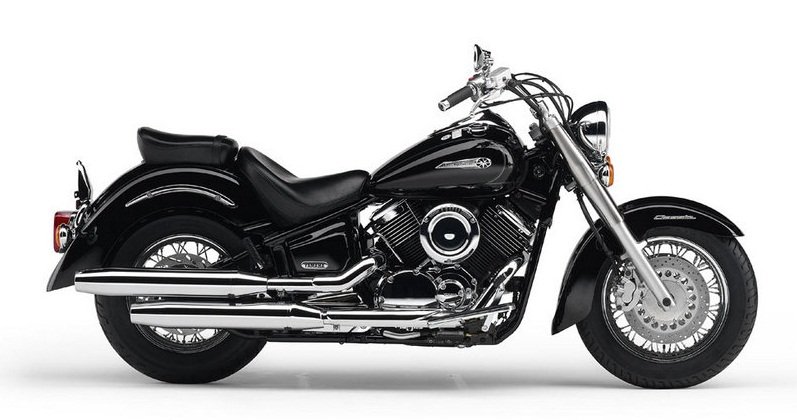
Yamaha Drag Star 400 (XVS 400)
The Yamaha XVS400 Drag Star cruiser model appeared in 1996 as a successor to the Yamaha Virago 400 model, differing from it mainly in a new duplex frame (instead of a backbone) and engine settings, which began to produce less power, but with a torque characteristic shifted to low and medium speed (operating speed decreased by 1000 rpm). As a result, the motor began to produce up to 33 Horse power and 32 NM’s of torque, with maximum performance of 6000 RPM.
The model is based on the older export version of the Yamaha XVS650 Drag Star, differing from it in engine displacement and restyling. In addition, the Yamaha Drag Star 400 was targeted only at the domestic Japanese market. 2017 was the last year the model was produced. Due to the release of further environmental restrictions, the Yamaha Drag Star 400 model can no longer be produced. Nevertheless, this model is widely represented at auctions, which makes it available for purchase pretty easily.
Price | $3,200 |
Engine | 4T, Fuel Injection, 399cc, 33HP |
Max Speed | 135 Km/h |
Weight | 209 Kg |
Seat Height | 71 cm |
Tank Volume | 15 Liter |
City Consumption | 16 kmpl |

Kawasaki Vulcan S
The Kawasaki Vulcan S cruiser model was first introduced in 2014 as a 2015 model. The motorcycle is the modern successor of the Kawasaki EN500 Vulcan. The model also has the name – Kawasaki EN650 Vulcan. The motorcycle was based on the engine from the Kawasaki ER-6 and Kawasaki Versys 650, which was slightly reconfigured (reduced maximum power, increased torque characteristics in the low and mid-speed zone) and placed in a steel diamond frame, giving an overall appearance similar to Harley Davidson V-Rod.
Speaking about the features; the motorcycle has an in-line 2-cylinder engine with a volume of 649 cc delivering 61 Horse power and 63 NM’s of torque, steel diamond frame, disc brakes front and rear (versions with ABS), electronic fuel injection, 6-speed gearbox, chain drive to the rear wheel and a fuel tank of 14 liters. In general, the concept of Kawasaki Vulcan S is to offer the market a motorcycle with a brutal appearance, reminiscent of the design of power cruisers, but in terms of equipment and character; comparable to the usual modern road bikes (light weight, comfortable fit, medium-volume engine, good dynamic characteristics, and economical).
Price | $7,000 |
Engine | 4T, Distributed Injection, 649cc, 61HP |
Max Speed | 180 Km/h |
Weight | 229 Kg |
Seat Height | 70 cm |
Tank Volume | 14 Liter |
City Consumption | 23 kmpl |
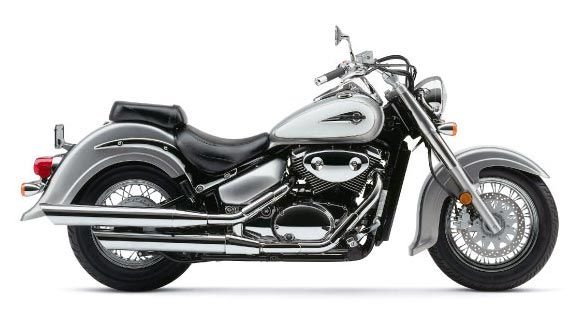
Suzuki Volusia 800
Suzuki’s series of classic cruisers were first seen in 1992, with the appearance of Suzuki VS800 Intruder, replacing the Suzuki VS 750 Intruder. In 1996, an offshoot appeared – Suzuki VZ800 Desperado / Marauder, and since 2001 – Suzuki VL800 Volusia. These modifications are almost identical in technical terms, built on the basis of the same engine and differ only in layout. Since 2005, Suzuki has combined these modifications into a common Boulevard line for the American market:
Suzuki VS800 Intruder -> Suzuki Boulevard S50
Suzuki VL800 Volusia -> Suzuki Boulevard C50 (C50T – Touring version)
Suzuki VZ800 Marauder -> Suzuki Boulevard M50
For the European market, these modifications had the following names:
Suzuki VL800 Volusia -> Suzuki Intruder C800
Suzuki VZ800 Marauder -> Suzuki Intruder M800
All modifications of the Suzuki Intruder 800 were based on a 2-cylinder V-shaped liquid-cooled engine, producing from 50 to 55 horse power. Early versions of motorcycles are distinguished by a carburettor power system, newer ones (2004-2005) have an injector from the GSX-R sports series with double chokes (SDTV system).
Price | $4,500 |
Engine | 4T, Fuel Injection, 805cc, 52HP |
Max Speed | 165 Km/h |
Weight | 241 Kg |
Seat Height | 70 cm |
Tank Volume | 16 Liter |
City Consumption | 22 kmpl |
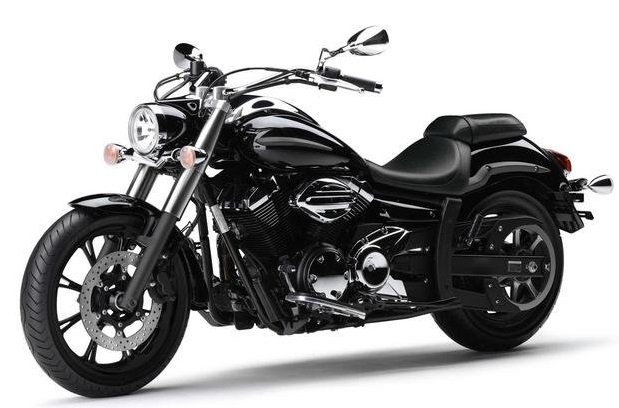
Yamaha Midnight Star 950
The Yamaha XVS 950 Midnight Star cruiser was first introduced in 2009 as a junior replacement for the Yamaha XVS 1100 Drag Star (in 2008, the XVS1100 evolved into the XVS1300). In our American market, this model is called the Yamaha V-Star 950. The model positions itself as a cruiser for entry-level and intermediate-level riders. Having full-size dimensions, the motorcycle is very similar to the older version of the Yamaha XV1900, which is also an advantage and deprives the feeling of owning a cheap small-capacity version of the older model.
The motorcycle was based on a 2-cylinder V-shaped air-cooled engine with a volume of 942 cc delivering 54 horse power and 77 NM’s of torque. This engine was subsequently installed on the Yamaha XV950 Bolt model as well, which appeared in 2013.
Price | $3,500 |
Engine | 4T, Fuel Injection, 942cc, 54HP |
Max Speed | 155 Km/h |
Weight | 278 Kg |
Seat Height | 67 cm |
Tank Volume | 17 Liter |
City Consumption | 24 kmpl |

Honda Rebel 250
The Honda Rebel 250 cruiser model began its history in 1985 as a motorcycle for training beginners; both men and women. The classic layout and controls made it possible to lay the foundations for controlling a chopper-styled bike and subsequently switch to a full-fledged and ultra-modern motorcycle. Light weight, simplicity and reliability of the main components / assemblies made Rebel 250 an ideal motorcycle for newbies.
The model gained great popularity in the states of North America, and for several years it was even sold in Europe. It is also known by the name ‘Honda CMX 250’. The main feature of the Honda Rebel 250 is the air-cooled, in-line 2-cylinder 234 cc engine that produces around 19 Horse power and 19 NM’s of torque. The maximum performance of the motor is reached at 5500-6500 RPM. Other features include a classic steel frame, 5-speed gearbox, drum rear brake, simple suspension in the form of a conventional telescopic fork in the front and a double shock absorber in the rear.
Price | $2,500 |
Engine | 4T, Carburettor, 234cc, 19HP |
Max Speed | 110 Km/h |
Weight | 136 Kg |
Seat Height | 67.5 cm |
Tank Volume | 10.5 Liter |
City Consumption | 28 kmpl |
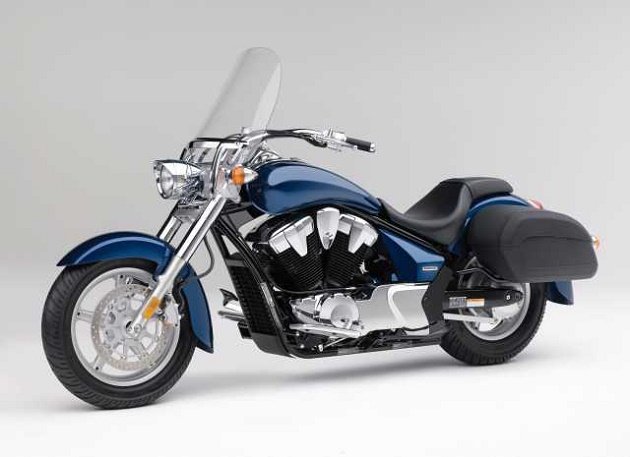
Honda Shadow 400
The Honda Shadow 400 series cruiser begins its history in 1997, when an updated model was presented as the successor to the Honda Steed 400; the Honda Shadow 400, which, like the Steed, had the factory code NV400. Despite this, Steed continued to be released in parallel until 2001, offering new modifications and minor updates. The Shadow 400 came out at the same time as the Honda Shadow 750 ACE as its “little brother”, built on a common base, but with a Steed 400 engine. Subsequently, both models (750 and 400) underwent the same restyling, and also offered almost the same modifications, which could only differ in names. Simply put, the Shadow 400 copied the Shadow 750’s “big brother” in almost everything, practically the same motorcycle, but with a different engine.
Price | $4,500 |
Engine | 4T, Fuel Injection, 398cc, 31HP |
Max Speed | 145 Km/h |
Weight | 232 Kg |
Seat Height | 69 cm |
Tank Volume | 14 Liter |
City Consumption | 32 kmpl |
Bottom Line
Any type of advice regarding which cruiser to choose as a beginner pales in front of one fact; motorcycles should be chosen not with the mind, but with the heart. To understand whether it is “yours” or not, you need to sit down and ride. If the price suits your budget – take it home! The main thing that should be considered while making a decision is inner harmony. Good luck on the road, ride safe!




